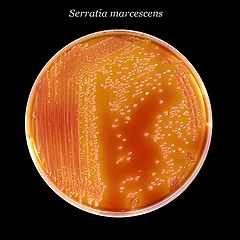Serratia
| Serratia | |
|---|---|
 | |
| Serratia marcescens, a typical species, on XLD agar.[1] | |
| Scientific classification | |
| Kingdom: | Bacteria |
| Phylum: | Proteobacteria |
| Class: | Gammaproteobacteria |
| Order: | Enterobacteriales |
| Family: | Enterobacteriaceae |
| Genus: | Serratia Bizio 1823 |
| Species | |
|
S. entomophila | |
Serratia is a genus of Gram-negative, facultatively anaerobic, rod-shaped bacteria of the Enterobacteriaceae family. The most common species in the genus, S. marcescens, is normally the only pathogen and usually causes nosocomial infections. However, rare strains of S. plymuthica, S. liquefaciens, S. rubidaea, and S. odoriferae have caused diseases through infection.[2] Members of this genus produce characteristic red pigment, prodigiosin, and can be distinguished from other members of the family Enterobacteriaceae by their unique production of three enzymes: DNase, lipase, and gelatinase.[3]
Infection of humans
In the hospital, Serratia species tend to colonize the respiratory and urinary tracts, rather than the gastrointestinal tract, in adults. Serratia infection is responsible for about 2% of nosocomial infections of the bloodstream, lower respiratory tract, urinary tract, surgical wounds, and skin and soft tissues in adult patients. Outbreaks of S. marcescens meningitis, wound infections, and arthritis have occurred in pediatric wards. [4]
Cases of Serratia arthritis have been reported in outpatients receiving intra-articular injections.
History
S. marcescens was once thought to be a nonpathogenic bacterium. Because of the red pigment it produces, it was widely used to trace bacterial transmission and to study settling and drifting of bacteria in air currents. In 1950, the US Navy conducted a secret experiment called "Operation Seaspray" to study wind currents that might carry biological weapons. They filled balloons with S. marcescens and burst them over San Francisco. Shortly thereafter, doctors in the area noted a drastic increase in pneumonia and urinary tract infections.[5][6]
References
- ↑ Images courtesy of CDC (http://phil.cdc.gov/phil/home.asp) Accessed 7 July 2011.
- ↑ Basilio J. Anía, M.D. "Serratia". eMedicine. Retrieved 2007-03-14.
- ↑ "Serratia". University of Texas at Houston Medical School. Archived from the original on 2007-01-28. Retrieved 2007-03-14.
- ↑ Health Canada. MSDS - Infectious Substances. Serratia. (http://www.phac-aspc.gc.ca/lab-bio/res/psds-ftss/msds138e-eng.php) Accessed 7 July 2011.
- ↑ Richards, Bill (1979-09-17). "Navy Fogged Bay Area With Bacteria; Navy Ship 'Attacked' Bay Area With Bacteria Laden Smog in '50". The Washington Post (Final ed.) (Washington D.C.). pp. A1.
- ↑ Richards, Bill (1979-09-17). "Secret germ warfare smog created over SF". The Modesto Bee (Morning ed.) (Modesto, CA). pp. A1, A14.